
LOYALTY CODE:
The paper code cannot be redeemed when browsing in private/incognito mode. Please go to a normal browser window and enter the code there

LOYALTY CODE:
The paper code cannot be redeemed when browsing in private/incognito mode. Please go to a normal browser window and enter the code there
This content is copyright protected!
However, if you would like to share the information in this article, you may use the headline, summary and link below:
Title: Half of crimes against farmers not reported
Survey finds that nine out of ten farmers use security measures with locking gates and keeping a dog being the most popular.
https://www.farmersjournal.ie/half-of-crimes-against-farmers-not-reported-321806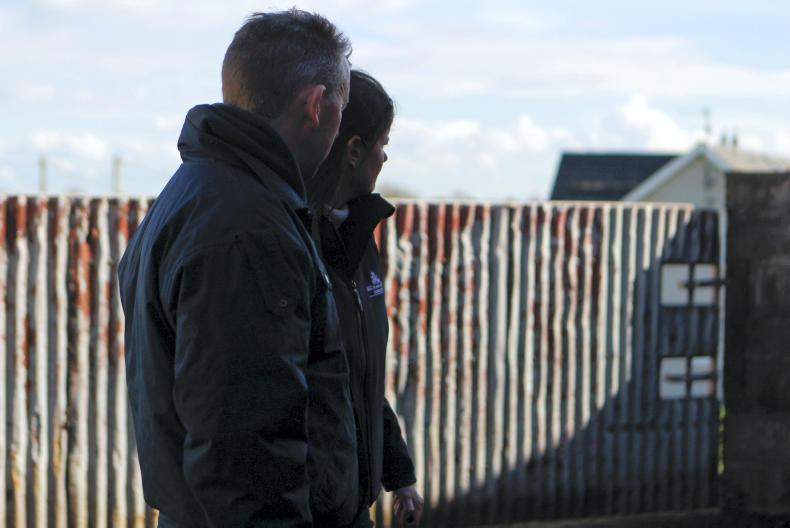

ENTER YOUR LOYALTY CODE:
The reader loyalty code gives you full access to the site from when you enter it until the following Wednesday at 9pm. Find your unique code on the back page of Irish Country Living every week.

CODE ACCEPTED

You have full access to farmersjournal.ie on this browser until 9pm next Wednesday. Thank you for buying the paper and using the code.

CODE NOT VALID
Please try again or contact us.
For assistance, call 01 4199525
or email subs@farmersjournal.ie
Sign in

Incorrect details
Please try again or reset password
If would like to speak to a member of
our team, please call us on 01-4199525
Reset
password
Please enter your email address and we
will send you a link to reset your password

If would like to speak to a member of
our team, please call us on 01-4199525
Link sent to
your email
address
![]()
We have sent an email to your address.
Please click on the link in this email to reset
your password. If you can't find it in your inbox,
please check your spam folder. If you can't
find the email, please call us on 01-4199525.
![]()
Email address
not recognised
There is no subscription associated with this email
address. To read our subscriber-only content.
please subscribe or use the reader loyalty code.
If would like to speak to a member of
our team, please call us on 01-4199525
 This is a subscriber-only article
This is a subscriber-only article
Update Success !
Just over half of agricultural crime is reported to gardaí by the affected farmers, according to a new survey of 861 farmers. It found that in 55% of crime incidents the farmer reported to gardaí while in 45% of cases the incident was not reported. The level of recovery of stolen assets is very low, it found. In fact, respondents recorded fewer assets as being recovered by gardaí than by other means.
The findings are in a survey on agricultural crime commissioned by the ICSA. It looks at reporting of agricultural crime to the gardaí and at crime prevention measures used by farmers. Agricultural crime was categorised into:
More incidents of theft and criminal assault were reported to gardaí than not reported. In contrast, a minority of incidents of VCDT and fraud were reported. Theft and VCDT were more likely to be reported when the asset was insured.
Almost nine out of 10 respondents employed at least one crime prevention measure. The most popular were locking gates and use of a dog. Other measures included locking up equipment, locking gates or otherwise securing land or buildings, recording serial numbers or tag numbers, and use of warning signs.
The authors state that this is the first such survey and that it will form a baseline for future studies.
Victimisation of farmers
Approximately two thirds of farmers had experienced crime in the 30 months to mid-2016. These farmers break down as 25% experiencing just one incident, with the other 41% two or more. The most common types of crime were those coming under the heading of vandalism, criminal damage and trespass (VCDT). These were 47% of all crimes. Next was theft at 43%. Criminal assault and fraud were substantially lower at 5% each.
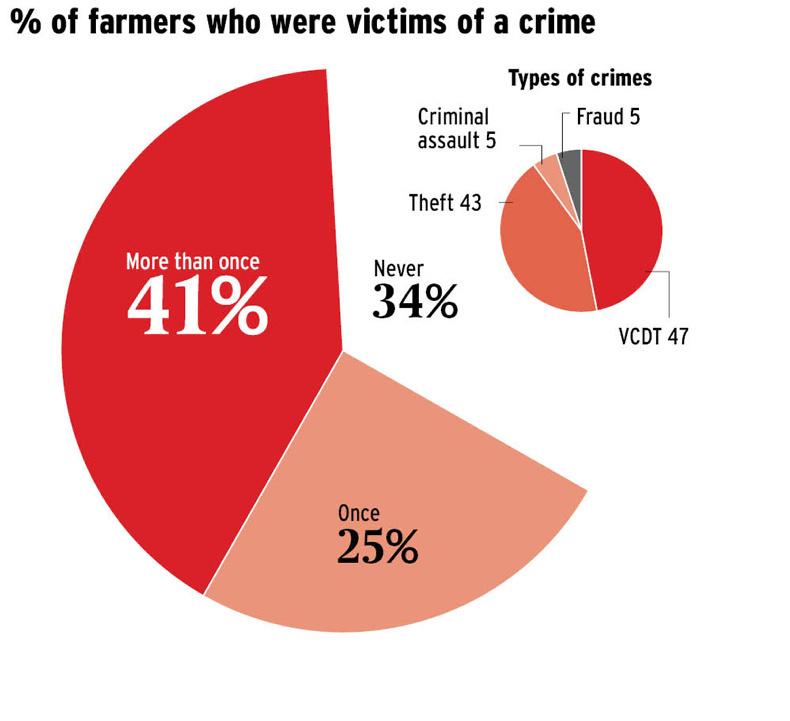
Reporting to gardaí
Overall, more crimes were reported to Gardai (55%) than were not (45%). Where the crime was theft, nearly two thirds (63%) were reported.
For criminal assault, 71% were reported. Conversely, where the crime was VCDT or fraud, most were not reported.
For VCDT, less than half (47%) of incidents were reported, for fraud only 26% were.
Value of stolen items
Where a theft was reported to gardaí, the value of the stolen items averaged €2,365. Where theft was not reported, average value was €1,861. Where the crime was robbery involving force or threat of force, all incidents were reported to gardaí and average value was €4,375.
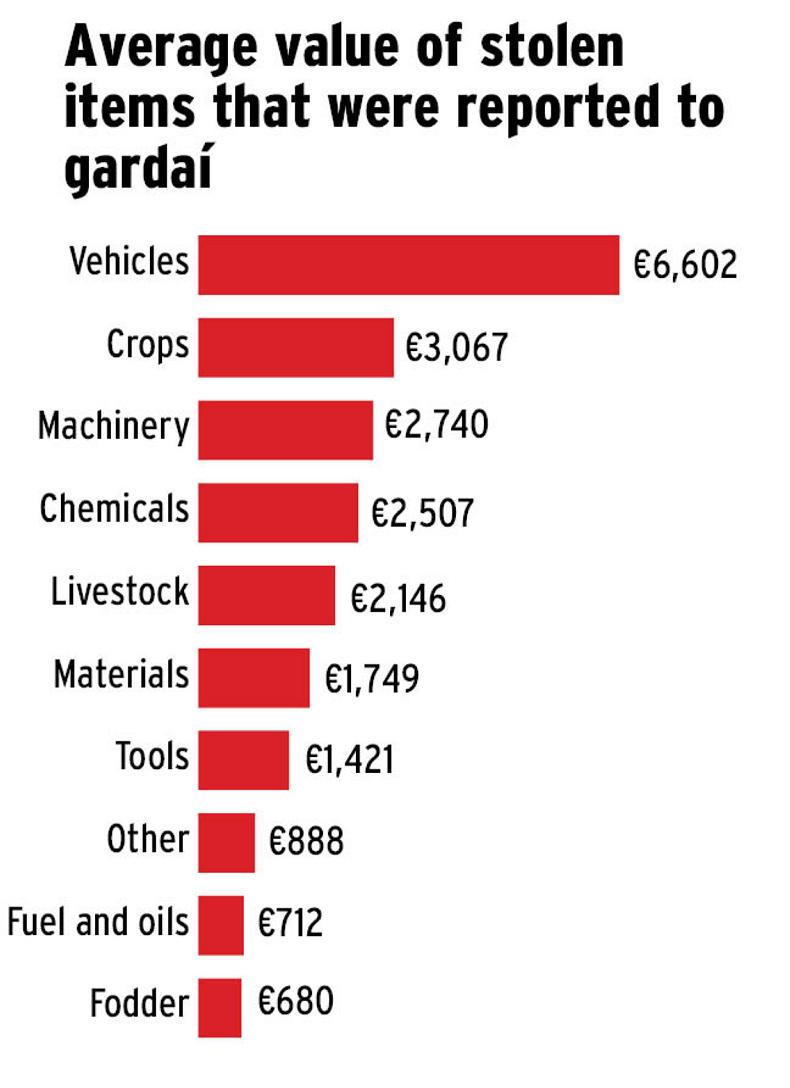
Diesel most often stolen
Fuel and oils were the items most commonly stolen, with the bulk of this accounted for by theft of green diesel. Exactly half of thefts of green diesel were reported to gardaí. The average value of diesel reported stolen was €705 compared with an average value of €415 where the crime was not reported.
Among these categories, the stolen items with the highest average values were vehicles, crops and chemicals. Where theft of vehicles was reported to Gardaí, the average value was €6,602. Where not reported, it was €1,238.
Where theft of crops was reported, average value was €3,067, where not reported €589. Where theft of chemicals was reported, average value was €2,507, where not reported €115.
Recovery of stolen items
The survey found that recovery of stolen items was rare. Of the 554 thefts which were reported to gardaí, items were recovered, fully or partially, in 55 of these cases. Gardaí were involved in 21 of these recoveries, but not in the other 34.
The category of item most often recovered was vehicles. There were 52 such thefts reported to gardaí and in 18 of these thefts assets were recovered.
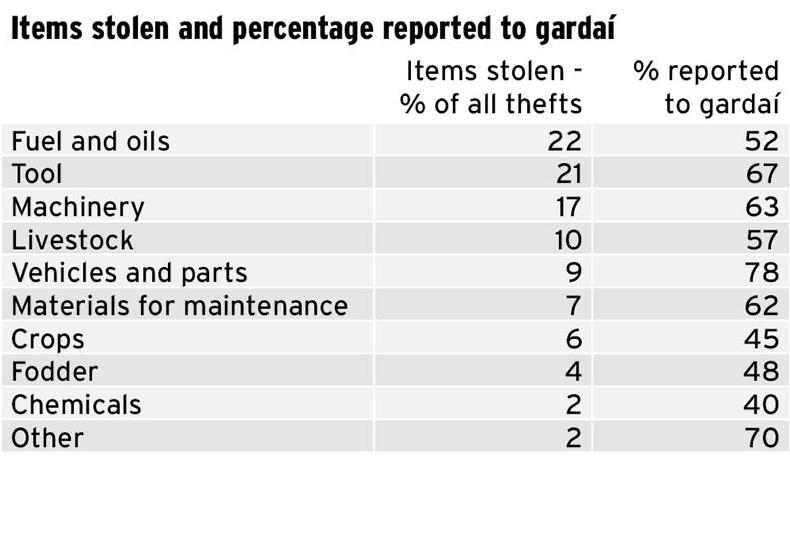
Trespass
Farmers provided details for 561 incidents under the heading of vandalism, criminal damage or trespass. Trespass made up nearly two-thirds (65%) of these cases. They were quite evenly divided between poaching, dumping and general trespass. Farmers reported 44% of trespass incidents to gardaí but not the other 56%. Vandalism to personal property and land were less frequent than trespass.
The financial costs arising from trespass were relatively low. Higher costs arose from vandalism to personal property. For example, in trespass cases reported to gardaí:
In contrast, where vandalism to personal property was reported to gardaí, the losses were:

Prevention measures
Nine out of 10 farmers used some crime prevention measures. There was some linkage between use of a prevention measure and likelihood of being a crime victim. Almost all farmers (99%) who had not experienced a crime used one or more prevention measures. In contrast, 83% of farmers who experienced a crime use one or more measures.
When farmers were asked about securing their land and yards, it emerged that:
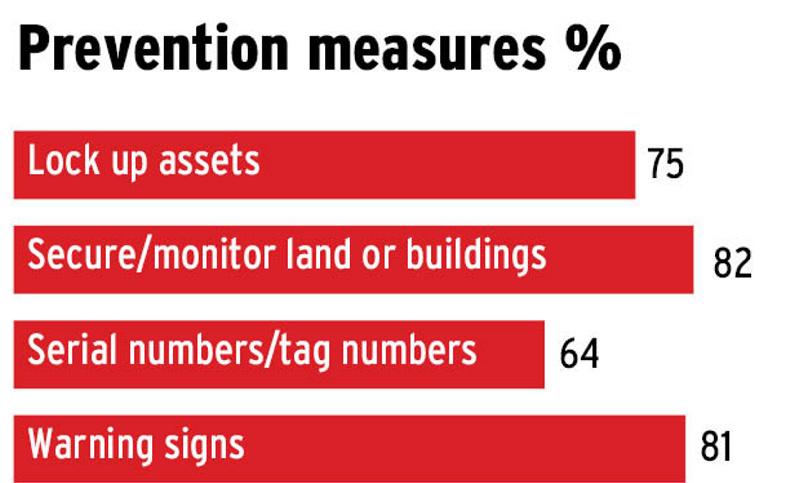
Other popular steps included:
SHARING OPTIONS: